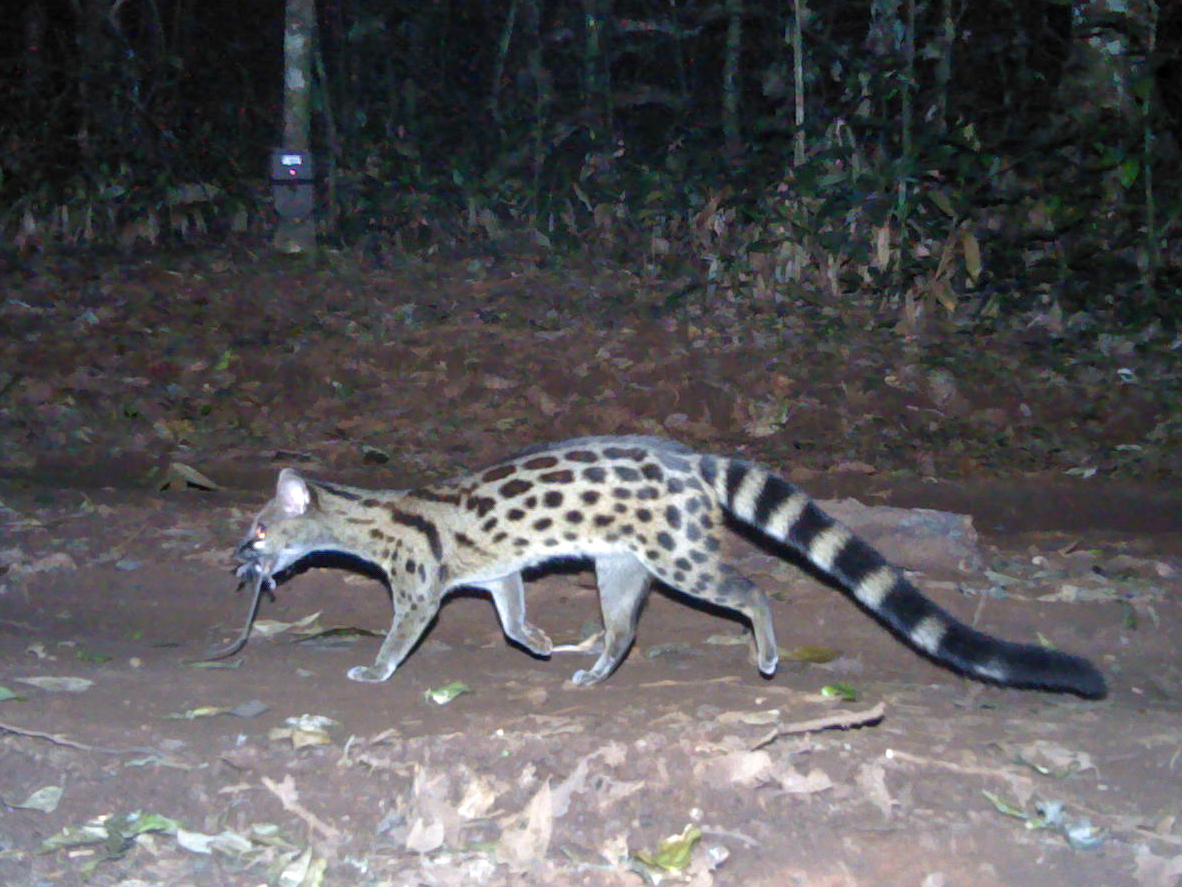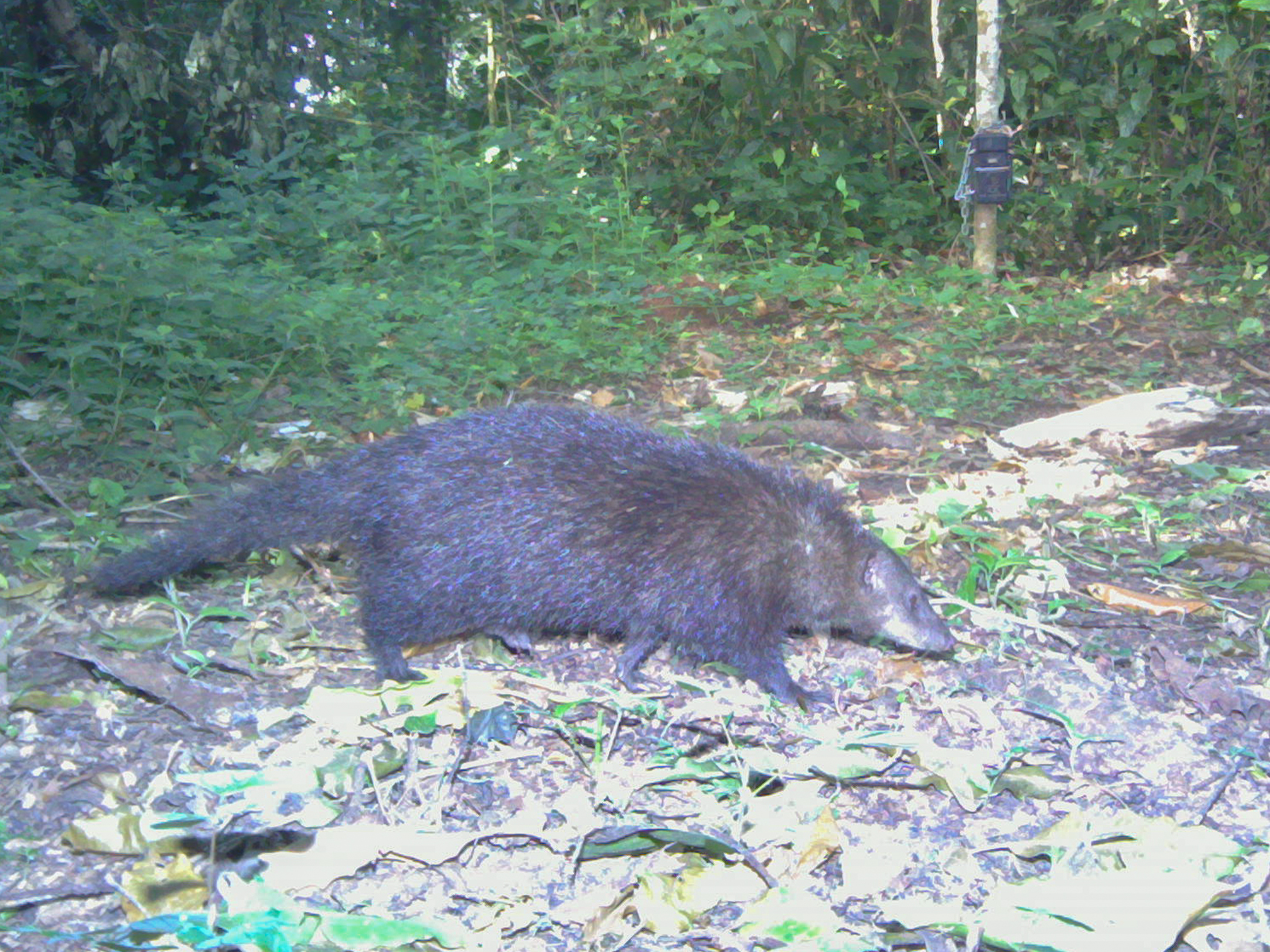African palm civet (and dish cleaner), Ngogo research station, Kibale
All photographs © David Mills
All camera trap images © David Mills / Panthera / WCS
Kibale’s small carnivores
When I arrived in Kibale National Park, I was aware that we knew next to nothing about African golden cats. I soon discovered that we knew next to nothing about a surprising number of the small carnivores in the forests of the Congo Basin. Kibale isn’t technically in the Congo Basin. It’s an isolated forest on the periphery of the great Congo forest. Long ago, it was connected, but the Albertine Rift hosts some of highest densities of people in Africa and that connection was severed as rainforest gave way to agriculture.
This means that Kibale is an effectively isolated forest in the midst of deforested farmland. The carnivore community in Kibale reflects this, with forest specialists (pictures below on the left) and open habitat or woodland specialists and generalists (pictures below on the right) intermingling.
Serval Leptailurus serval
African golden cats are most closely related to caracals Caracal caracal and servals. Both of these species tend to prefer open habitats or woodland and leave the African rainforest to golden cats. As a tribute to Kibale’s past connection to the Congo Basin, we photographed an individual with the servaline morph (bottom right), which is more commonly found in Central African regions, such as eastern DR Congo. In Kibale, servals were only found in or near open grassland areas. Despite the fact that these open areas are separated by closed forest, a small population seems to be thriving. Outside the forest, they survive along papyrus swamps. Servals are thought to eat chickens (and probably do), and are reported to be killed by dogs (I know of one verified report). Even medium sized carnivores like this one have trouble surviving around humans. Protecting papyrus swamps may be essential to their long term survival in some areas of Uganda.
African palm civet Nandina binotata
This primarily arboreal carnivore is my second favourite species in the forest. Only one other person has studied them - in the 1970’s! They are the only remaining species in their family (Nandiniidae). Even though they’re carnivores, they eat mainly fruit. This brings them into conflict with famers growing bananas, mangoes, and other fruits near Africa’s forests. Since they are forest specialists, they are highly threatened by deforestation.
African civet Civettictis civetta
This species is found everywhere in Africa except in the desert. It’s amazing that no one has studied them in detail. This species thrives around humans because they are omnivores. They scavenge from food refuse pits and thrive on the high rodent population associated with human settlements. During my PhD research, we found that their densities in farmland were 5X higher than in forest. They also produce civetone, an essential ingredient in many perfumes. Most commercial civetone is now synthetic, thankfully.
Servaline genet Genetta servalina
This genet species is forest dependent. They are the most widespread genet species in African forests, but quickly go extinct when that forest is cut down. They have similar diets as the rusty-spotted genet (below), and both are nocturnal, so they reduce competition by using different habitats.
Rusty-spotted genet Genetta maculata
The large-spotted genet complex is the most widespread genet group in Africa. They tend to thrive round humans, probably for the same reasons as the African civet. They also scavenge from rubbish pits and hunt rodents. When forest is cut down and servaline genets disappear, this is the species that will often take their place.
Marsh mongoose Atilax paludinosus
This species is widespread across Africa. Usually they prefer watercourses, where they hunt water dwelling things like crabs. In Central African Republic, a close relative, the long-nosed mongoose, dominated the forest. In Kibale, this mongoose rules. Distance to water does not seem to matter. We photographed them over 3000 times! Of course, they were responding to bait. They were much less common in farmland. In this landscape, they may also require forest cover to thrive.
Large grey mongoose Herpestes ichneumon
We rarely photographed this large mongoose. They were only active in grassland and farmland. Even in farmland, they were active during the day. I don’t know how they navigated in a landscape with a human population of > 300 ppl/km2 plus their dogs. Understanding their strategies would be useful for conservation planning.
Alexander’s cusimanse Crossarchus alexandri
This group living relative of the mongooses is very poorly studied. They are clearly present in Kibale because we photographed them in several areas. However, we photographed them extremely rarely. This species urgently requires more research to understand their ecological requirements.
Slender mongoose Herpestes sanguineus
This small mongoose is usually solitary. As you can see in this camera trap picture, their coat colour varies more than in most mongooses. We also detected this species very rarely. We don’t know whether this is due to their small size, habitat choice, avoidance of trails where we put cameras, or low density.
Banded mongooses Mungos mungo
This group living mongoose is found across much of Africa. They do not typically enter high forest, so it was a bit surprising to find them in Kibale. We only found them in bushy areas or near grassland. One group had a curious habit of associating with one particular baboon troop. Every time we saw the baboon troop or captured them on camera, the mongooses were close behind. They were no doubt cleaning up the insects unearthed by the baboons’ feeding.
Congo clawless otter Aonyx congicus
This is another Congo species that was found in Kibale. The closely related Cape clawless otter Aonyx capensis is found across the rest of East and Southern Africa. Very little is known about these species. The African Otter Network has launched an initiative to collect sightings data and collect baseline data on this species. I helped them produce an ID sheet to help people distinguish between the species.
Honey badger Mellivora capensis
These are a notoriously aggressive species. They have even been known to stand up to lions. They are found in a wide range of habitats, from desert to woodland and even tropical forest. However, we didn’t detect them often in Kibale. We don’t know the reasons for this, or why they were really only found in a small area around the Ngogo research station. Understanding what keeps them there and prevents them from being more common in other parts of Kibale would help us to understand that community better.














